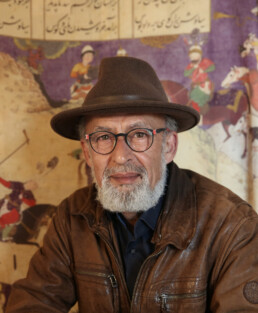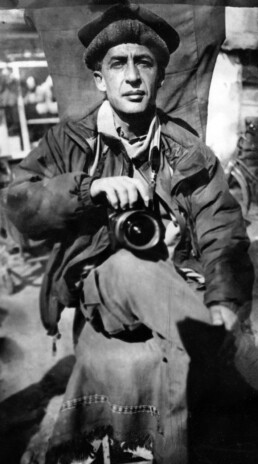
© Clara Deghati
Manoocher Deghati is 67. He is a photojournalist, war correspondent and teacher. But first and foremost Manoocher is an Iranian. And he has not seen his native country for over 35 years.
“I was destined to become a photojournalist”
It all began in 1978. The young Manoocher, who had spent four years in Rome studying cinema with the ambition of becoming a cameraman, returned home to Iran. At that time there were rumblings of revolt: the people were rising up against the Shah and his repressive policies. Students had taken to the streets demanding greater freedom and democracy. As the production of films for cinema had come to a halt, Manoocher grabbed his equipment and went out to record the history of his country for posterity. Armed with his camera and a few rolls of film he photographed demonstrators and soldiers, and began working for the Sipa Press agency and AFP. The first accolades followed – he was awarded the World Press first prize in 1984 – and so did the first repressive measures: his photos of child soldiers and executions irritated the authorities. He was imprisoned, beaten and threatened. His press card was confiscated several times. In 1985 the risks had become too great and Manoocher decided to flee his country. He went into exile in France with his wife and his daughter Maral, who was only one year old at the time. This was the beginning of a long journey and a long career all over the world, sometimes marked by incredibly fortuitous timing.
“I never really had time to think about changing jobs”
After he had spent a few months in Paris, AFP asked Manoocher to take part in developing their international bureaus. He decided to go to Central America “in order to get away as far as possible from the Middle East”. Based in Costa Rica, he worked with local photographers covering the wars and social crises that were raging in Guatemala, Nicaragua and El Salvador, and he was in Panama during the invasion by the United States in 1989. After Iran, this was the second time Manoocher had found himself at the heart of the news. At the beginning of the 1990s he took over as bureau chief for AFP in Cairo, where he covered the Israeli-Palestinian conflict in particular. The photojournalist once again found himself in the thick of the news when Yasser Arafat returned to Palestine after 27 years of exile. Jerusalem, Somalia, the Gulf War, the siege of Sarajevo…Manoocher’s career continued but was temporarily halted in 1996 when an Israeli sniper shot him in the leg in Ramallah. He was very seriously wounded and had to be repatriated to France, where he spent 18 months in the military hospital of Les Invalides – the only civilian among all the veterans. He sorted his photos in his room, producing features for AFP. During his stay there he received a visit from President Jacques Chirac: he granted him French citizenship, which would make international travel much easier from then on. On his return to the field, Manoocher covered official visits abroad by the French Government. In 2000 he was a victim of the controversial visit by Lionel Jospin to Palestine: he was hit on his weakened leg by the Prime Minister’s car as it was fleeing from the stones being thrown. It was the same story again: repatriation, Les Invalides and a forced break. But in spite of the risks, Manoocher felt he had a mission and refused to give up taking photographs, speaking out and bearing witness. He had understood for many years that “photographs make an impact, they enable society to be told, they give a voice to the voiceless”.
“Taking photos of the living, the will to live, the hope”

© Fardin Waezi
Always driven, Manoocher continued to cover the conflicts that marked the beginning of the 21st century, and notably the war in Afghanistan. It was there that he began a new career alongside his brother Reza, also a photojournalist: he became a teacher. In this “totally devastated” country the two men created an NGO called Aina and provided the benefit of their experience to young Afghans. The school has trained many journalists since its creation and has enabled new publications to be disseminated. Manoocher was later called upon by the UN to become a teacher within IRIN, the United Nations humanitarian press agency. Based in Nairobi, he would train more than a hundred photographers. In January 2011, with a career of 30 years behind him, he became head of Associated Press’ photography department in Cairo. Once again, his taking up of a new position coincided with a burning topic of news: the Arab Spring erupted barely 36 hours after his arrival. Egypt, Syria, Libya, Yemen, Iraq…one outbreak of demonstrations and uprisings followed another. Manoocher was managing 150 photographers and the media coverage was so dense that he was only getting 4 or 5 hours of sleep a day. Speaking several languages, he held the keys to working in this part of the world. One of his teams, of which he was head, would receive the prestigious Pulitzer Prize in 2013 for its report on Syria.
“There’s not really such a thing as retirement if you’re a photojournalist!”
As the situation in Egypt was becoming more and more dangerous for journalists, Manoocher and his family left the country. He was tired, and in 2014 he decided to settle in the Apulia region of Italy. He bought a farm where he grows vines. He continues his career as a photographer surrounded by his family and his many animals, but far from war zones. In October 2021 he will be Jury Chair for the 28th Prix Bayeux Calvados-Normandie. The man who embraced his destiny with a career spanning 45 years as a photojournalist modestly calls this “A great honour”.
A FEW DATES
1954 ❱ Born in Urmia, Iran
1980 ❱ American Deadline Press Club, Special Achievement prize
1984 ❱ World Press, first prize in the news category for his photos of the Iran-Iraq war
1986 ❱ World Press Photo, third prize
2002 ❱ Set up Aïna, photography school in Kabul, Afghanistan
2004 ❱ Howard Chapnick Award for Advancement of Photojournalism
2012 ❱ Jury member, World Press Photo
2019 ❱ Publication of Iran : Rêves et dérives (Iran: Dreams and Excesses), co-published with his brother Reza, with texts by Rachel Deghati
2020 ❱ Publication of Eyewitnessed, a biographical work written by his wife Ursula Janssen, an archeologist and writer
